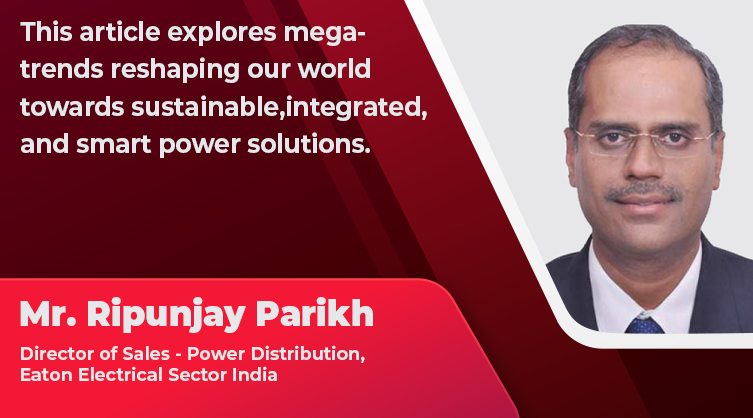Integrating the future of efficient and sustainable energy distribution
By EPR Magazine Editorial October 7, 2023 11:39 am IST
By EPR Magazine Editorial October 7, 2023 11:39 am IST

This article explores mega-trends reshaping our world towards sustainable, integrated, and smart power solutions.
Today, we find ourselves facing unprecedented challenges. Daily news reports highlight natural catastrophes linked to global warming and carbon emissions. As a response, the world is fully committed to embracing technologies that can mitigate these issues. This article will explore the emerging mega-trends in the energy sector, the changing power landscape, and the importance of integrating renewable energy, electric vehicle (EV) infrastructure, and energy storage for a sustainable and efficient energy distribution network.
One prominent trend is the increasing adoption of electrification over traditional fossil fuels. With the rise of electric vehicles (EVs), the world’s demand for electricity is expected to surge by 50 percent compared to current levels.
Another key trend is the growing role of renewables. Currently, renewables contribute around 25 percent of global power generation. However, a shift is underway, with ambitious plans like India’s commitment to add 500 gigawatts of renewable power by 2030, which presents an opportunity to add more than 300-400 gigawatts in the next eight years.
Digitalisation is revolutionising
The energy sector by creating interconnected, smart systems. These systems enhance efficiency, reliability, and overall grid management. Ensuring resilient power distribution networks is crucial. While larger metropolitan areas tend to have stable grids, rural and urban regions often experience lower-quality power. Government initiatives aim to improve this situation.
Changing Power Landscape
Traditionally, power generation and distribution followed a linear path, with centralised power plants transmitting electricity over long distances to end-users. However, the future landscape is set to shift dramatically. Localised generation, especially from renewable sources like solar, is becoming more prevalent. The concept of ‘prosumers’ is emerging, where consumers use and produce electricity.
Solar power will be a primary source of localised generation, reducing reliance on distant power plants. Traditional grid power from utilities will still play a role in the overall energy mix. Charging stations will form a unique node in the ecosystem, requiring dedicated infrastructure and power systems. Energy storage systems will be essential for managing fluctuations in renewable energy production and peak demand, helping reduce grid stress. Importantly, these elements will be seamlessly integrated into a common platform.
The Role of Energy Storage
Energy storage is a critical component of this ecosystem. It addresses the intermittent nature of renewable energy sources by storing excess energy when available and releasing it when demand is high. This not only enhances grid reliability but also reduces peak demand charges.Modern energy storage systems are compact, versatile, and easily installed in various locations. They serve as a buffer between power generation and consumption, improving overall system stability.
EVs are becoming increasingly popular, necessitating dedicated charging infrastructure. To ensure efficiency, fast-charging systems need to operate at 96-97 percent efficiency, reducing energy waste and system strain.
Digital Transformation
Digitalisation underpins the entire ecosystem. Smart software systems manage power distribution, ensuring optimal utilisation of available resources. This software can decide when to draw power from the grid, use stored energy, or rely on local generation.
One innovative approach involves containerised systems that house all the necessary components. These containers can be placed conveniently outdoors, making most of the available space. They can even be deployed underground, preserving valuable surface space.
Integration is key to realising the full potential of this energy ecosystem. Common software platforms bring together various solutions and allow for intelligent management of power usage. Users can monitor their systems, track energy generation and consumption, and use differential tariffs to optimise energy costs.
The energy sector is at the cusp of a transformational shift. Mega-trends like electrification, renewable energy dominance, digitalisation, and resilient grids are shaping the future of energy. A sustainable energy ecosystem is emerging, where local generation, grid power, EV charging infrastructure, and energy storage work harmoniously.
Companies like Eaton are pioneering solutions to integrate these elements seamlessly, enabling efficient, reliable, and sustainable energy distribution. As the world continues to confront climate challenges, this integrated approach to energy offers hope for a brighter and more sustainable future
We use cookies to personalize your experience. By continuing to visit this website you agree to our Terms & Conditions, Privacy Policy and Cookie Policy.